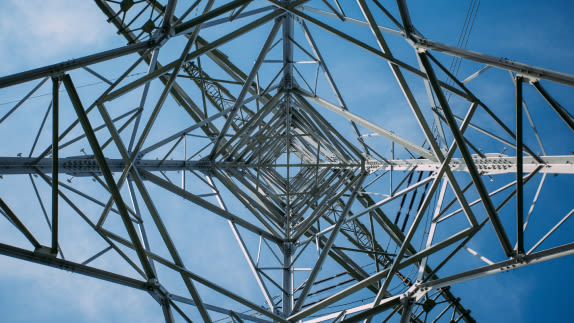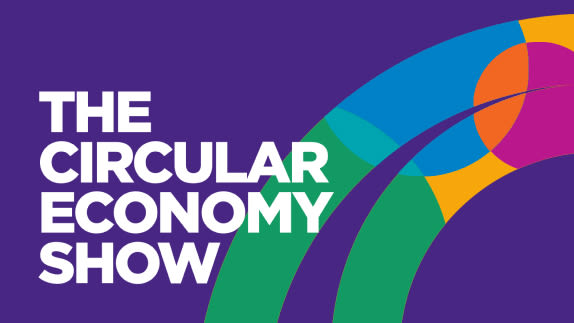In this Circular Economy Show Podcast episode, we hear from Reuben Chorley, Sustainable Industrial Operations Director at Jaguar Land Rover. Together, we will dive deeper into the world of i-Pace Jaguar car batteries and how these are being given a second life in the renewable energy sector.
Listen on Spotify, Apple Podcasts, or wherever you get your podcast.
Click to expand
Reuben Chorley 0:00
Companies now are looking at that triple bottom line now, which is, you know, the people, the planet, and the profit because it's not just about making money, it's about doing it in the right way with our people and doing it in a way that doesn't cost the earth so to speak, to make sure that the planet is there and is, is there for our children and grandchildren, so on as well.
Pippa Shawley 0:19
Welcome to the Circular Economy Show Podcast. I'm Pippa and in this episode, I spoke to Reuben Chorley, Sustainable Industrial Operations Director at Jaguar Land Rover, about the importance of collaboration on their circular economy journey. The automobile company is aiming to achieve net zero emissions across its products and operations by 2039, and expects that 80% of its sales will be battery electric vehicles by 2030. This shift to batteries presents a new challenge for Reuben and his colleagues: how to ensure that they are kept in use for as long as possible, maximising their potential use. To address this, Jaguar Land Rover has partnered with Wykes Engineering, to take the batteries from its engineering fleet of I-pace Jaguar cars, and use them to plug a gap in the renewable energy sector. I started by asking Reuben, about how a car company ended up branching out into this area.
Reuben Chorley 1:16
So really, this came down to applying circular economy principles. So rather than look at it and say, we're a car company, and we built cars, we looked at it and said, Well, what have we got as a product? And as a product, we had an energy storage system, essentially. So how could you apply that differently? Okay, so we started to explore different... different options and different partnerships, and talking to companies like Wykes, who we've done lots of good, great work with now. We started to understand that within the renewable sector, there is a a problem that that as there's more and more wind more and more solar being generated within the UK grid, sometimes it's not windy, and it's not sunny, bright, sunny, when we want to use our power. So if that's the case, if say, 2030 an increasing, maybe 40-50% of our energy comes from renewables, well, if it's midnight, and there's no wind, we're not going to get much, much solar or much wind energy. So how do you do that? And sometimes it's really windy, really sunny when nobody wants once the energy so they had a need of balancing almost when they're generating it to when they need to put the energy into the grid. And of course, the two come together really well. So by working with, with Wykes, and applying that principle, you know, our own principle of use less, use longer, use again, it was really clear that we could take their, their understanding and take our understanding of the battery, put that together, and help to solve a problem. Not so much a problem for us, because we could just say let's just recycle it, that's fine. Put it into recycling, that's fine. But we felt obliged to do more. But they had a real problem, in that, if we weren't working with them about second life batteries, then ultimately, they've got to buy new batteries, that will create a need for, you know, a new product on the market, rather than take something that's already in existence, applied to a different application to solve the problem that they've got.
Pippa Shawley 3:10
Keeping products and materials in use is a key pillar of the circular economy. So how does this project work? Reuben says that once a battery is removed from a vehicle, it's taken to a triage hub.
Reuben Chorley 3:21
We then test the battery pack, we understand what's the state of health of the various modules. So within a battery pack, let's say there's 10 modules. And each one has, let's say, small batteries, like you'd be, you'd look at your your AA batteries within those modules, we then test those - are they balanced, are they in a good state of health? So we then get a report that says this is the health of the battery, do we need to make any adjustments, do we need to update anything or change anything, but then it goes to Wykes, they would then integrate that into essentially a shipping container. So they've got shipping containers at their wind and solar farm. They integrate that into... 30 packs into a container. Each battery is about 90 kilowatt hours. So each container can be up to three megawatts of energy. And that will then mean that when the generating electricity essentially goes into the battery, if it's not going to grid, because obviously straight to grid is the first thing, if it doesn't go to grid, it goes into battery stack stacks that they've got. And then when the grid needs it, they can discharge and then start recharging again. So those batteries essentially are being charged up through the day, and either discharged in the day or discharged at night as and when the grid has has the demand for it. And as I said those at the moment are our own batteries from our engineering fleet that are coming back. And we're developing it so that actually it can be any battery that we have can start to feed into this process and the system as well.
Pippa Shawley 3:57
And it doesn't stop there. Reuben and his team are exploring potential third lives for the used car batteries.
Reuben Chorley 4:54
It depends on the battery, to be honest, because some of them if they degrade to a point where where we think it almost it gets to a point where it can't hold its charge, then we'll have to take it to a to a recycling facility and then take the the elements out of it again and feed that back into new batteries. But we are also exploring third life as well. So other applications that we could use it for, and it depends on how the battery is made. There could be applications for third life as well. So we're exploring different options, in that sense going forward as well, after energy storage systems, after supporting wind and solar, is there something else we can do with it as well? So, again, trying to maintain that, you know, use less, use longer, use again, as much as we can, before we then put it into a recycling facility.
Pippa Shawley 5:38
And are you allowed to tell us anything about those third life options?
Reuben Chorley 5:42
We're exploring very early things, but some of it is around mobility, there could be some, you know, could be something in smaller mobile solutions that have much shorter range, that have a different sort of weight that they're carrying. It might be we can do something in those in those spaces. But again, it's very exploratory at the moment and still to be to be worked through, I think is best way to put it.
Pippa Shawley 6:03
And you've talked a little bit there about collaboration. But you know, you've worked very closely with Wykes Engineering on this project. How important do you see collaboration in bringing circular economy and circular methods into the business?
Reuben Chorley 6:20
I think the best way to to answer that is to say we can't do it without collaboration, to be honest. We've, we've worked very well with Wykes, we're working, like I said, we're working with other companies as well. And I think we wouldn't have been able to do what we've done without working with, with someone like Wykes, because they've brought their expertise to us, in how to take what we know very well, which is the battery battery. And we understand the technology of that, we understand how to manage that battery with... the battery management system and how to cool it and how to control it. But they've got very good knowledge on on wind and solar, what the demands are, and then how to connect the two. We couldn't do that on our own, we might be able to, but it will take an awful long time. And it would cost an awful lot of money probably. So you know, collaborating in these sorts of areas is fundamental for what we're doing.
Pippa Shawley 7:12
And I think there are other businesses that are probably a similar size, with similar heritage to you, they're also thinking that collaboration is really necessary to make some of these changes to go beyond the linear economy. But I think there's probably also a nervousness of how much you share and you know, keeping your brand still, you know, their very strong sense of brand within it. How do you overcome some of that nervousness and know how much to give?
Reuben Chorley 7:43
It's a good question, it's a good question. I think we've got principally... I guess, you come back to your basic principles. Who are we as a company? Or do we want to be known as, what do we what do we want to achieve? And you find companies that have a similar ambition, or they have similar principles and how they work and how they they're being responsible in what they do and how they operate as a business. And you you try and find common ground. For us, the automotive industry is changing so much that the changes in the next 10 years will be the biggest change since the automotive industry was established. We're going from internal combustion engine to battery electric vehicles, the whole industry is moving. And customers are demanding that, right, they want electric vehicles, which is great. And you know, that takes time for us to develop and to get to that. And we've been doing collaborations in these new spaces now, you know, for many years, and to be honest, as an automotive industry, company, you have to collaborate anyway, with new technologies, with with new materials, that's something we do. But I guess the difference is we're applying a different business model to this one. So you know, we've always done the collaborations in the sense of our linear business model. So we, we build things, we sell things, and then we maintain them with our aftermarket teams by selling components to keep the cars running. But but essentially, we don't see those vehicles again. What we're looking at now more is actually we need to think about what's going to happen to that vehicle at the end of its life, what do we do differently with it? And actually, do we want that vehicle back? Because it might be because we know what's in that vehicle, we know what to do with it. And therefore we we can integrate it back into our into our own suppliers much more easily. So again, that's what we call system thinking change, moving from that linear to that circular piece. And I think probably every company is either doing that or will do that, to be honest. And if we want to be successful and be sustainable, we have to do that because we're not going to do it without it to be honest.
Pippa Shawley 9:43
And I wonder how much collaboration there is with your competitors. Because when it comes to things like charging stations, but also maybe things further down the line, where do they come in? How do you talk to them?
Reuben Chorley 9:59
So yes, with other automotive companies, our competitors, but but it's not unusual for companies to collaborate in, in a legal way. So you know, obviously we, we have to make sure everything everything is done open and transparent way. But there are you know, companies will collaborate so companies sell each other their own engines, you know, we've bought engines, for example, from Ford and from other other automotive companies and we've sold products to other companies as well. So there's that level of collaboration. I think when you talk about sustainability, certainly what I find is, there are quite a lot of of arenas whereby automotive and non government organisations can come together and they can talk about common problems facing the automotive industry, people are quite open in terms of what our challenges are. And then we're trying to share how what is working and what, what, what needs to happen differently. Because ultimately, as an automotive industry, we need to do things differently for our supply chain to do things differently so that our customers can experience things differently. So if we all do something completely, radically different to each other, there will be new, don't get me wrong, there will be new technologies, there'll be new experiences that that we'll be able to bring to bear. But there will be fundamental things that we will all have to do at the same time. So we're all moving to battery electric vehicles. So there's a bigger demand for for battery cells, there's bigger demand for, for for that whole industry. And there's less demand going forward in you know, 15/20 years for the internal combustion engine. So that area of the automotive industry is really going to shrink in the next 10/15 years, which is why it's such a big change. So we're seeing that kind of collaborations driven almost by our customers, in terms of what our customers want, will happen, because we'll be using similar suppliers, we'll be using similar supply chains. And where we can, certainly we'll we'll try and collaborate on the things that really matter as well. But again, it's new territory, it's new territory, we're exploring, and we're seeing what works. And we're seeing how we can deploy our expertise as best we can.
Pippa Shawley 12:03
With collaboration within the automotive industry playing a crucial role in scaling the use of electric vehicles, what about the role of governments and legislators?
Reuben Chorley 12:11
A lot of governments say they want to move, they want the automotive industry to move away from internal combustion engine to battery electric vehicles. And that's okay. But as you say, to really enable that when our customers buy a product, they need to know that they can drive and they can find a recharging point, and that it will maintain a certain level of convenience for them. At the moment, it's a bit of a challenge, because it's going through a transition. So I think in most countries, there is a challenge of, of how, how do you balance the demand and the need at the right time versus the investment that the government is putting in? But again, collaboration-wise, we recently announced that that North America, I think it is, that Tesla chargers can be used for JLR products now. So again, how can we use as much common systems as we can that are out there to help each other as well.
Pippa Shawley 13:02
And I guess that's another really great sign of collaboration, if you can use somebody like Tesla's charging points, you know, they've put the effort into the infrastructure, and it sort of saves... it means you can direct your energy somewhere else.
Reuben Chorley 13:14
Yeah. And this isn't this, this can't be solved by one government, one company, this is, like I said, is, don't underestimate the magnitude of this change. Because even when you get the charging points in place, you then need to get enough energy getting into that charging point, which means you need to change the grid. So you need to make sure the transformers are set up, right, you need to have enough power on demand. So this is all linked together into into a really big fundamental change for for all the automotive industry and for governments and local governments as well.
Pippa Shawley 13:41
And how can legislation and regulation help to encourage a circular approach to materials and to business?
Reuben Chorley 13:47
There's not much clear legislation about high voltage second life. So it's difficult to understand really, what do we do to make sure we're compliant? So we've had to get a lot of extensive third party advice to advise us, what should we do? How should we do it? Make sure we're not in breach of any dangerous goods or environmental... making sure we are environmental permits, and making sure that we're compliant with manual handling regulations. Because of course, when you move a battery that's brand new, from a factory to a car factory to put it together, we understand that very well. But when you take a battery out of a car and try and move what's essentially a secondhand battery that's been in use, is the regulation different? How do you store it? How do you manage it? And again, the transport industry is getting used to that type of question as well. So regulation has been probably the one I'd say we'd need to look at first next time, because that took quite a long time to understand.
Pippa Shawley 14:40
While moving away from the internal combustion engine, and extending the life of batteries is an important part of Jaguar Land Rover's circular economy journey. It doesn't stop there. So what else is the company doing to reach its net zero goals?
Reuben Chorley 14:53
We've said we're going to do Net Zero 2039. So we can do lots of work to reduce our co2 e within our scope three downstream and upstream to the products we buy plus a tailpipe, but we're never going to get to net zero unless we move away from the linear take, make, dispose kind of business model to that circular model of, of, you know, reuse, use less, use longer, use again, we're not going to get to net zero without that. So, you know, we're doing so much work in this space. So we're looking at circular resources. So we want to maximise recycling opportunities, renewables and replenishment of other things to reduce our non-renewable resources. So maximise renewable, maximise recycle as much as we can, circulate products and services, so extend the lifetime, and the, you know, the lifetime of our vehicles to maximise the realised value. So if we can keep the cars in its highest form, for as long as possible. That's pretty good, right? Not just the battery, but the entire vehicle, if you can keep a vehicle on the road, in a really good condition for much, much longer. And we're helping to do that as a business. That's the change in how we think about it, rather than just sell the product and sell components, actually had to keep that that vehicle, really, in its best possible use for as long as possible. And we'll do this by engaging within our entire ecosystem. And that's where we're starting to look at this more as an ecosystem to drive to change. It's, you know, it's our suppliers. It's our customers. It's a different interaction, potentially going forward with some of our customers as well, to embed that that real circular economy piece.
Pippa Shawley 16:31
As we've explored a lot on this podcast, there is no silver bullet when it comes to creating a circular economy. I think Reuben really highlighted the challenges of moving a well-established brand from the linear take, make, waste economy towards a circular one. But it was also great to hear how open to collaboration Jaguar Land Rover is, from their work with Wykes Engineering on giving their batteries second life, to working with their competitors in the automotive industry to create an infrastructure necessary to scale electric vehicles, and the need for regulation to make this happen faster. Thanks to Reuben for joining me, and to you for listening to this episode of the Circular Economy Show Podcast from the Ellen MacArthur Foundation. If you enjoyed it, please leave us a review. Or if you're listening on Spotify, drop us a comment in the q&a section. We'd love to hear from you. See you next time.





